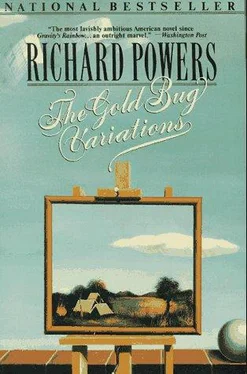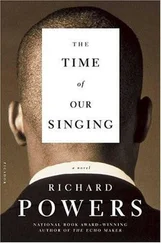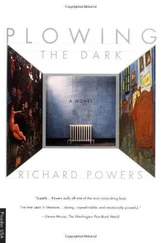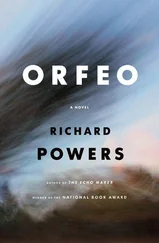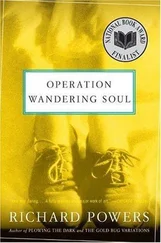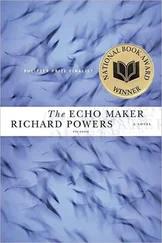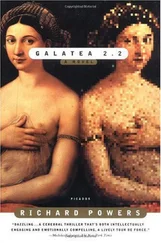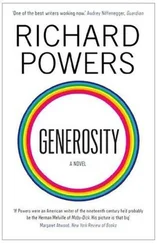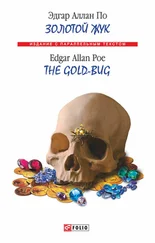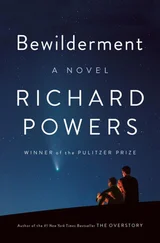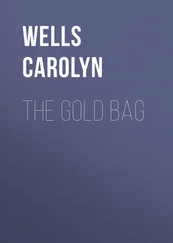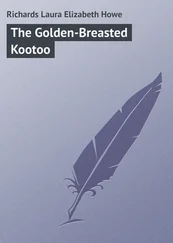Richard Powers - Gold Bug Variations
Здесь есть возможность читать онлайн «Richard Powers - Gold Bug Variations» весь текст электронной книги совершенно бесплатно (целиком полную версию без сокращений). В некоторых случаях можно слушать аудио, скачать через торрент в формате fb2 и присутствует краткое содержание. Год выпуска: 1991, Издательство: Harper Perennial, Жанр: Современная проза, на английском языке. Описание произведения, (предисловие) а так же отзывы посетителей доступны на портале библиотеки ЛибКат.
- Название:Gold Bug Variations
- Автор:
- Издательство:Harper Perennial
- Жанр:
- Год:1991
- ISBN:нет данных
- Рейтинг книги:5 / 5. Голосов: 1
-
Избранное:Добавить в избранное
- Отзывы:
-
Ваша оценка:
- 100
- 1
- 2
- 3
- 4
- 5
Gold Bug Variations: краткое содержание, описание и аннотация
Предлагаем к чтению аннотацию, описание, краткое содержание или предисловие (зависит от того, что написал сам автор книги «Gold Bug Variations»). Если вы не нашли необходимую информацию о книге — напишите в комментариях, мы постараемся отыскать её.
Gold Bug Variations — читать онлайн бесплатно полную книгу (весь текст) целиком
Ниже представлен текст книги, разбитый по страницам. Система сохранения места последней прочитанной страницы, позволяет с удобством читать онлайн бесплатно книгу «Gold Bug Variations», без необходимости каждый раз заново искать на чём Вы остановились. Поставьте закладку, и сможете в любой момент перейти на страницу, на которой закончили чтение.
Интервал:
Закладка:
The Enigma Variations
I find a footnote to the race for solution in his day, the story of Beadle's 1958 Nobel Prize for the elegant experiment equating one gene with one synthesized enzyme. On winning the prize, Beadle received a cable from Max Delbrück, a later prizewinner, reading:
ADBACBBDBADACDCBBABCBCDACDBBCABBA ADCACABDABDBBBAACAACBBBABDCCDB
CCBBDBBBAADBADAADCCDCBBADDCACA ADBBDBDDABBACCAACBCDBADCBDBBBA
The question could have sat unanswered on my board forever. I get out my decoder ring, put together everything I know about Beadle's and Delbrück's state of knowledge in 1958, and set to work cracking the telegram. I break the string into triplets. By '58, even post-docs knew to begin there.
ADB ACB BDB ADA CDC BBA BCB CDA CDB BCA BBA ADC ACA
BDA BDB BBA ACA ACB BBA BDC CDB CCB BDB BBA ADB ADA
ADC CDC BBA DDC ACA ADB BDB DDA BBA CCA ACB CDB
ADC BDB BBA
The message still means less than chance to me. But in the noise of these codons is a tip-off, an improbable distribution, something designed. The four independent letters appear freely in each position with one exception. The letter B occurs in the middle of only one codon: BBA. The unique nature of this most common trio suggests a special function, perhaps framing. I try a space; the message splits revealingly:
ADB ACB BDB ADA CDC BCB CDA CDB BCA ADC ACA BDA BDB ACA ACB BDC CDB CCB BDB ADB ADA ADC CDC DDC ACA ADB BDB DDA CCA ACB CDB ADC BDB
Three words end with BDB, the most common remaining codon. Taking a tip from Poe, I bank on this one standing for "e." The two-letter word affords another entree. A list of common English digraphs and a little knowledge of combinational restrictions make the nonsense spurt sense: "or," "code." I push on, lost in a perverse pleasure. The flush of success makes me feel strong, attractive, erotic. Suddenly, it's over.
BREAK THIS CODE OR GIVE BACK NOBEL PRIZE
Nothing compared to coaxing the truth out of Neurospora, yet the Nobel nominee needed help in the cryptanalysis. Beadle retaliated. He sent Delbrück a comeback code of his invention, which Delbrück also needed help in cracking. But Delbrück got in the last word. Beadle's scientific address before the awards ceremony in Stockholm was interrupted by the confused delivery, in mid-speech, of a package air-mailed Urgent. Beadle opened the crate to reveal a toothpick sculpture in the shape of a giant double helix. The tips of each toothpick were painted one of four colors. The pattern was irregular with hidden information. When Beadle's lecture broke up, the roomful of premier life science brains pushed up to the podium, studying the color sequence, speculating, testing propositions. At last someone — or not someone, but that collective twentieth-century organism Big Science — hit on the solution:
I AM THE RIDDLE OF LIFE. KNOW ME AND YOU WILL KNOW YOURSELF.
Both Delbrück codes are curiously self-referent. Break this code. I am the riddle; know me. What "me" could possibly proclaim itself the riddle? The cipher? The plaintext? The coding algorithm? The riddleness in the coder himself? What part of the DNA sculpture has the audacity to call itself "I"? The Delbrück code, the one inside the codemaker's "I," modified by no criterion except survival, grows miraculously capable of games. The I's have it. Know me and you will know yourself. I spend the afternoon playing with messages, and on no proof but my pleasure, feel as if I'm closing in on my discovery, me.
The Census
At night, I put away the substitution ciphers and return to the painting index. I search for that particular oil-on-panel. But only Brueghel surrenders to me. Pieter the Elder: the man who was what Bles might have been, had the lesser possessed the passion of ordinary events. In The Census at Bethlehem, burghers in a wintry, sixteenth-century Brabantine town go about their business — men carting cargo, women slaughtering animals, children playing furiously on lake ice — without noticing the holy couple queuing up in the foreground to be numbered in obedience to Herod's order, unaware of the coming slaughter.
Believing what we count, counting what we see:
A fistfight; gathered firewood; gutted pig-
grease caught in waiting pan.
These things are here at hand and present endlessly,
an endless repetition of infolded theme.
What was it that we hoped to settle
on by census, counting, inventory, roll?
While earth runs to frozen iron ball we number
Now as if already gone.
This time we say we'll get it straight
sum the total, number all the fear
that snows the town in at the end of year,
the spur, the memory that drives men out
onto the frozen sea to map its edge
for clues to the mystery that was here
all along sends children out on sleds
with their own keen sense of the contested game:
Believing nothing lost that's lived, counted, named.
Today the Pilgrimage of Grace occupies York, thirty years before Brueghel's census. Religious sectarian revolt, same genus as the violence daily sweeping the Near East to my absolute bafflement. Today is the first newspaper to be printed regularly in New York City, 1725. The first of those loose-leaf folders filled with Bruegh-elian specific figurescapes whose holy historicity no one ever manages to feel. Today is a town square packed with people: Marie Antoinette guillotined, 1793; battle of Leipzig, 1813; first use of ether in surgery, 1846; Harpers Ferry raid, 1859; excavation of the Cardiff Giant, 1869; British halting the Germans at Ypres, 1914; 1,200 killed in Yangtze troopship explosion, 1926; Bengal struck by cyclone, 1942; China's A-bomb, 1964. Anachronisms as persistent as the Flemish church in the background of a scene showing Mary and Joseph's arrival in Bethlehem.
"I have this persistent fantasy," Franklin told me, holding the cold bed linen to his neck as he spoke. "Met de Bles seeing that incredible panel, from the far side, a dozen years after his death. Knowing at once that his compatriot has spelled out in specific, radiant, complex, floating detail the nomenclature of human ecology that Herri himself had been born to describe, but died unable to articulate."
Near Where the Wheatfield Lies Cut Down
I met Todd on the steps of the Met, sitting in the middle of a Brueghelscape of tourists, pushers, impoverished art students, culture vultures, religious questers, Van Meegeren society frauds, footsore pedestrians sitting a minute, delinquent office workers taking a late lunch, and the occasional pilgrim of grace who simply liked looking at paintings. Frank stuck out of the assembly, even a block away, the one anomaly in the packed crowd. The first time I ever saw him in broad daylight.
Incredible weather, a June detour en route to November. I'd walked from two subway stops away, to discharge the jitters and give myself another chance to back out. Walking, I saw Manhattan as I hadn't for a long time. I remembered why I'd come here— the epitome of epitomes, the most convoluted, aggressive, over-stimulating tabula rasa imaginable. The place was just bizarre enough, packed with sufficient diversity of neighborhoods, for me to make of it anything I wanted.
I saw him from a block off — outside the cave. He was exhilarated by the crowd. Here, in midday, he had lost nothing of the air I'd assigned him at our first meeting. He met me halfway down the steps, pumped my hand vigorously. "Great idea, this. Haven't been here since late last week." He rushed ahead and paid our admissions, over my protest. Then we fell into the quiet of the galleries.
We could head down any corridor of this maze, choose our century, school, bias, genre. We could buzz through, a masterpiece a minute, or stand all afternoon in front of one portrait. With every imaginable way of seeing to choose from, we made no choice. We wandered, letting each step determine the next. Franklin knew the galleries by heart. He could set in on a topic, wheel slowly around a corner, and land us in front of a picture that I'd realize had been the topic's inspiration, even from the previous room.
Читать дальшеИнтервал:
Закладка:
Похожие книги на «Gold Bug Variations»
Представляем Вашему вниманию похожие книги на «Gold Bug Variations» списком для выбора. Мы отобрали схожую по названию и смыслу литературу в надежде предоставить читателям больше вариантов отыскать новые, интересные, ещё непрочитанные произведения.
Обсуждение, отзывы о книге «Gold Bug Variations» и просто собственные мнения читателей. Оставьте ваши комментарии, напишите, что Вы думаете о произведении, его смысле или главных героях. Укажите что конкретно понравилось, а что нет, и почему Вы так считаете.
